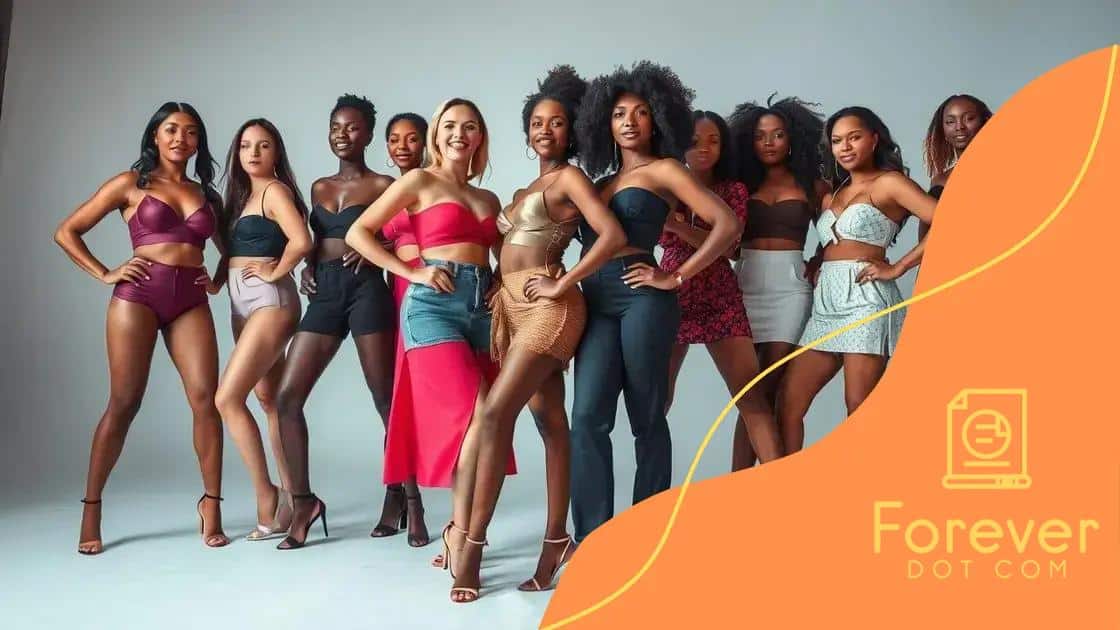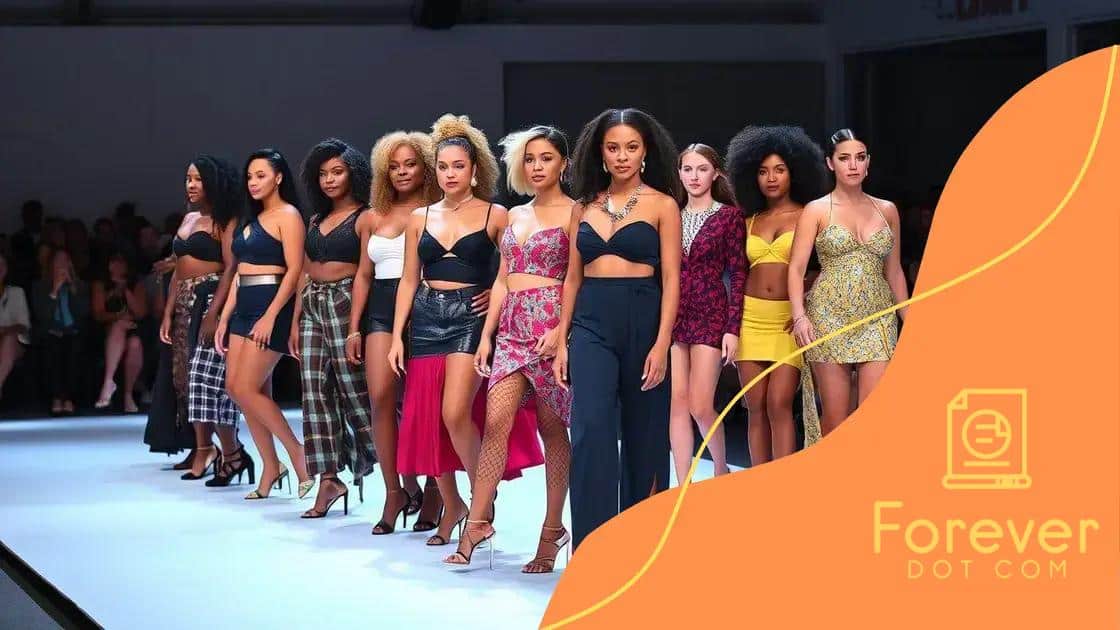The impact of body positivity movements on modeling

The impact of body positivity movements on modeling is significant, as they challenge traditional beauty standards and promote inclusivity by embracing diverse body types across the fashion industry.
The impact of body positivity movements on modeling is reshaping how we perceive beauty in today’s society. Have you noticed the shift towards inclusivity in fashion? This article explores the evolution and significance behind these movements.
Understanding body positivity and its origins
Understanding body positivity is essential to appreciate its impact on modern modeling. This movement challenges traditional beauty standards and insists that everyone, regardless of their size, deserves to feel beautiful and confident. But where did it all begin?
The Origins of Body Positivity
Body positivity emerged as a response to unrealistic body images often portrayed in media and fashion. It creates a space where individuals can embrace their bodies and celebrate diversity. Originally centered around those with eating disorders, it has expanded to include all body types.
Key Influences
Several key movements have influenced the rise of body positivity:
- The feminist movement, advocating for women’s rights
- Social media platforms amplifying diverse voices
- Plus-size models gaining visibility and respect
These influences have fostered a community that encourages self-love and acceptance. With the growth of the internet, individuals began sharing their stories, creating a powerful support network.
Shifting Perspectives
Today, the conversation around body positivity is broader than ever. It’s not just about size but about accepting differences in all forms. This shift has prompted the fashion industry to reconsider its practices, resulting in more inclusive sizing and representation.
As more brands embrace body positivity, we see changing attitudes in advertising and runway shows. Consumers are demanding authenticity, which leads to positive changes throughout the industry.
Ultimately, understanding body positivity helps us appreciate the ongoing journey toward inclusivity in fashion and modeling.
Key figures in the body positivity movement
Key figures in the body positivity movement have played a vital role in shaping its message and effectiveness. They raise awareness about body acceptance, influencing both individuals and the fashion industry. Some of these iconic personalities have become symbols of change.
Influential Advocates
Many individuals have made significant contributions to the body positivity movement:
- Jameela Jamil – A prominent actress and activist, she founded the I Weigh movement, promoting self-acceptance.
- Ashley Graham – As a plus-size model, she has advocated for diversity in fashion and challenged conventional beauty standards.
- Lizzo – A singer and body positive activist, Lizzo encourages self-love through her music and public discourse.
These figures inspire millions to embrace their bodies and reject harmful societal norms. They use social media platforms to share their stories and create communities that celebrate all body types.
The Impact of Their Work
The impact of these advocates extends beyond their personal journeys. They influence brands to adopt more inclusive practices, such as offering diverse sizing and featuring models of all shapes and sizes. This shift helps consumers feel represented and valued.
Moreover, their efforts have sparked conversations about mental health, self-esteem, and diversity. As the movement grows, more voices contribute to the dialogue, allowing for broader representation and acceptance.
Understanding the contributions of these key figures illuminates the ongoing battle for body positivity and the changes we continue to see in society.
How body positivity influences modeling standards

Body positivity significantly influences modeling standards today. This movement has shifted how beauty is defined, embracing a variety of shapes and sizes. As a result, the modeling industry is becoming more inclusive than ever before.
Changing Beauty Standards
Traditionally, the modeling world often showcased a narrow definition of beauty, promoting unrealistic body types. However, the body positivity movement has challenged this norm, pushing for a more diverse representation in fashion.
Brands and designers are now beginning to recognize that beauty comes in all forms. This change is evident in advertising campaigns and runway shows that feature models of various sizes, ethnicities, and abilities.
The Role of Social Media
Social media has played a crucial role in advocating for body positivity. Platforms like Instagram allow models and influencers to share their stories and promote body acceptance. They create communities where individuals feel empowered to embrace their bodies.
- Models showcase their authentic selves, emphasizing self-love.
- Campaigns communicate messages of acceptance, inspiring others.
- Hashtags like #BodyPositivity encourage conversations about diversity.
This visibility helps dismantle stereotypes and fosters a culture that celebrates uniqueness. Furthermore, social media’s influence encourages brands to adopt inclusive marketing practices to resonate with consumers.
The shift in modeling standards due to body positivity is not just a trend; it’s a movement toward authenticity and diversity in the fashion industry. As more brands support this ideal, the future of modeling looks brighter for everyone.
The role of social media in shaping perceptions
The role of social media in shaping perceptions of body image is profound. Platforms like Instagram and TikTok have become arenas for discussions about body positivity. They allow individuals to share their stories and challenge societal norms.
Platforms as Tools for Change
Social media provides a space for advocates to reach a wider audience. Many people follow influencers who promote body acceptance and self-love. These influencers often share raw and candid moments that resonate with their followers.
- Influencers post unfiltered photos to celebrate their bodies.
- Stories highlight personal journeys of self-acceptance.
- Hashtags like #BodyPositivity expand the conversation beyond individual experiences.
This visibility encourages others to embrace their unique qualities. Through sharing diverse body types, social media promotes a more inclusive idea of beauty.
The Power of Community
Moreover, social media fosters a sense of community. Many users find support in others who share similar experiences with body image. This online environment helps individuals realize they are not alone in their struggles.
As discussions about body image evolve, social media has the power to challenge traditional beauty standards. Brands have taken notice, leading to more inclusive marketing strategies that reflect the diversity of their audience. This shift is critical for creating a more accepting society.
Ultimately, the influence of social media is reshaping public perceptions of beauty and self-worth.
Challenges faced by the body positivity movement
The body positivity movement has made significant strides, but it also faces several challenges. Understanding these obstacles is essential to recognizing the ongoing journey towards inclusivity and acceptance in society.
Societal Pressures
One major challenge is the persistent societal pressure to conform to traditional beauty standards. Many media platforms still promote unrealistic images, making it difficult for individuals to fully embrace body positivity. These messages can lead people to feel inadequate or disconnected from the movement.
- Advertising often highlights a narrow definition of beauty.
- Social media can propagate harmful comparisons.
- Cultural norms may influence self-perception negatively.
Despite the movement’s efforts, these pressures remain strong and can challenge progress.
Internal Conflicts
Another challenge stems from internal conflicts within the movement itself. Different groups may have varying interpretations of what body positivity means. Some argue that it should focus on all body types, while others may emphasize specific issues like eating disorders or mental health. This diversity of thought is valuable but can also lead to divisions.
Additionally, individuals might struggle with self-acceptance despite the movement’s messages. This internal conflict can be disheartening for many, as they may feel they are not fitting the ideals of the movement.
Commercialization and Exploitation
The commercialization of body positivity can also pose significant challenges. Brands may adopt the movement’s language and imagery without committing to true inclusivity. This commodification can dilute the original intent of promoting body acceptance.
Moreover, some organizations may exploit the movement for profit, undermining its goals. While representation in advertising is crucial, it should not be just a marketing strategy but a genuine effort toward inclusivity.
These challenges highlight the complexities of the body positivity movement. By acknowledging and addressing these issues, advocates can continue to work towards building a more accepting society.
FAQ – Frequently Asked Questions about the Body Positivity Movement
What is the body positivity movement?
The body positivity movement aims to challenge and change societal standards of beauty, promoting acceptance of all body types.
What challenges does the body positivity movement face?
Challenges include societal pressures to conform to traditional beauty standards, internal conflicts within the movement, and commercialization by brands.
How has social media influenced body positivity?
Social media has allowed individuals to share their stories, create supportive communities, and promote diverse representations of beauty.
Why is body positivity important?
Body positivity is important because it promotes self-acceptance, boosts mental health, and encourages diversity in how beauty is perceived.






